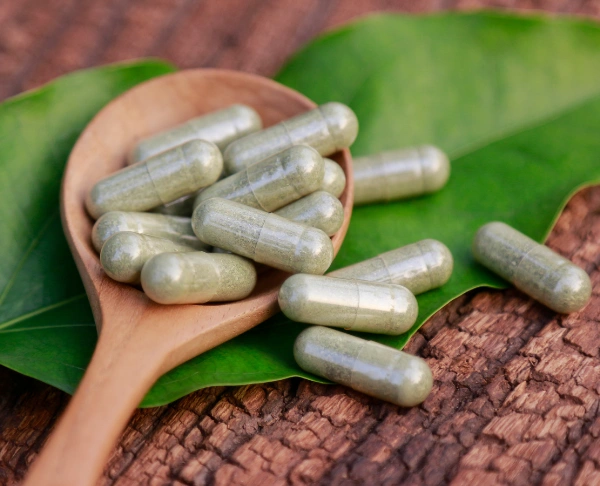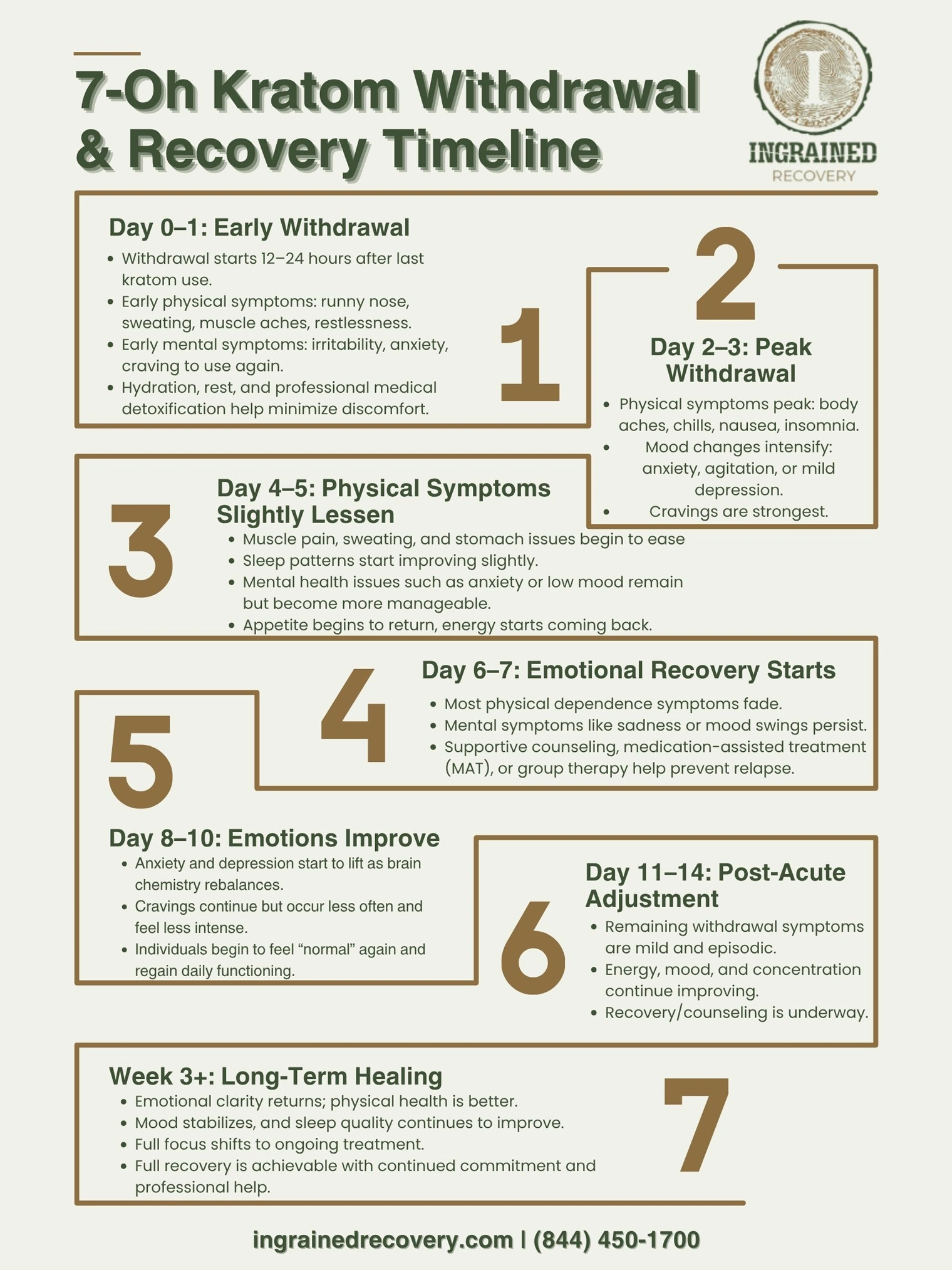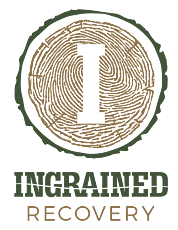Withdrawing from 7 Oh Kratom and Detox Treatment Options at Ingrained
Many have recently started to use Kratom products as a “natural treatment” for pain relief, anxiety, or for boosting energy. But just because a dietary supplement is natural (or bills itself as ‘natural’) doesn’t mean it is safe.
One of the product’s strongest compounds, 7-hydroxomitragynine (7-Oh Kratom), is created when the body metabolizes mitragynine, Kratom’s active ingredient. It binds to the opioid receptors in the brain, creating similar effects to painkillers, heroin, and other opioids. It explains why 7 Oh kratom withdrawal symptoms can be challenging to manage.
The Ingrained Recovery team understands that Kratom withdrawal can be complicated, especially when someone engages in 7-Oh Kratom misuse. The healthcare professionals at our Eastman, Georgia, provides support for those who struggle with drug and alcohol dependence and underlying medical conditions.
This blog resource will take a close look at Kratom, the physical and mental symptoms of withdrawal, and a typical opioid withdrawal timeline.
Get Accredited Treatment Programs at Ingrained Recovery

7-OH Kratom Abuse and The Nature of Kratom Addiction
Kratom comes from a tropical Southeast Asia native plant, Mitragyna speciosa. Its leaves contain kratom alkaloids, including mitragynine and 7-hydroxymitragynine, which bind to the brain’s mu opioid receptors like prescription pain relief pills.
The alkaloids bind to those receptors, where they can alter brain chemistry and provide short-term relief from chronic pain and anxiety. However, they also lead to substance abuse when people try to achieve the same effect over and over again.
The Food and Drug Administration (FDA) has not approved Kratom products for any medical use. Kratom isn’t listed in the Controlled Substances Act, although FDA regulators hope to add it. Research suggests that, with extended use, Kratom affects tolerance and withdrawal symptoms.
Ultimately, use escalates from kratom dependence to a substance use disorder (SUD).
Why Higher Doses of 7 Oh Kratom Increase Dependence and Withdrawal Severity
With longer duration of kratom use, the body starts adapting to the active alkaloids. With continued drug abuse, the person requires higher doses to achieve the same opioid-like effects, a condition called tolerance.
Once the person develops tolerance, they need to use kratom more frequently and/or in higher doses. As the opioid use disorder (OUD) progresses, they start to have severe symptoms if they try to discontinue use on their own.
Get Proven Detox and Rehab Options at Ingrained

What are the Symptoms of 7 Oh Kratom Withdrawal?
Mental and physical dependence on Kratom can lead to a variety of uncomfortable symptoms when trying to stop using it. The intensity and duration of these stem from several factors, including how long someone uses kratom, whether they mix it with other drugs, and the typical dose.
Kratom withdrawal symptoms are generally less severe than other opioid withdrawal symptoms. But it still leads to significant distress and myriad symptoms:
The Most Common Physical 7 Oh Kratom Withdrawal Symptoms
The physical side effects when stopping use are usually moderate withdrawal symptoms, similar to other opioid addictions. Common physical complaints include:
- Muscle aches
- Fatigue
- Sweating
- Runny nose
- Gastrointestinal distress/digestive system upset
- Tremors
- Chills
- Restlessness
Some more severe withdrawal symptoms include changes in heart rate and sudden blood pressure fluctuations, which explain why medical supervision is necessary when ending dose-dependent kratom abuse.
The Typical Psychological Symptoms of Ending 7 Oh Kratom Dependence
- Besides physical discomfort, cessation can lead to behavioral health and mental health risks. Some things to watch for are the following:
- Anxiety
- Depression
- Mood swings
- Irritability
- Intense cravings
- Difficulty focusing on tasks
Because of the mental health issues that can arise from ending any drug dependence, quitting cold turkey at home is not safe. Seeking professional medical detoxification help can keep the person comfortable and in good health.
Britney's Story Shows How Kratom Abuse Progresses

‘Britney,’ a 21-year-old collegiate gymnast, suffered a severe ankle injury. The athlete went from daily training to forced rest. After her short pain medication prescription, she was still sore but eager to get back to her sport. She spotted kratom products on the shelf at a convenience store and thought that a natural product would be safe.
At first, Britney took low doses of kratom capsules. Within a few weeks, she needed more frequent doses to manage the pain. By the end of the spring semester, she used it several times a day, sometimes chasing kratom with wine. She tried to stop but experienced muscle aches and insomnia, so she used it again.
The Support of Loved Ones and Overcoming Self Medication With Kratom
Britney’s parents noticed her irritability and fatigue as soon as she arrived home for summer break. Admitting her problem to her family was a relief. Her dad’s health insurance covered treatment costs, allowing her to receive medical detoxification and intensive therapy.
She learned that she had no stress management tools, so the sudden disruption in her routine left her with no way to cope. Medications helped reduce her cravings and lessen her mood swings.
By the start of the fall semester, Britney was training again. But she now had a new awareness of her need to manage stress. She found a mental health support group on campus and attends a bi-weekly counseling session. She’s also started to mentor other student athletes, raising awareness on the risks of self-medicating after sports injuries.
Britney’s story shows how easy it is to find kratom and start abusing it. It’s also illustrative of how early intervention and family support can be keys to making a full recovery.
The Health Risks of Long-Term 7 Oh Kratom Use
Many start using powder form kratom to relieve pain, but soon experience unpredictable effects on both the brain and the body. Because the alkaloids activate the same receptors in the brain as opioids, continuous use can cause similar long-term harm.
Over time, users can experience adverse events such as overdoses with respiratory depression, hormonal changes, liver strain, or heart complications.
7 Oh Kratom Addiction and Polysubstance Abuse: A Dangerous Mix
Polysubstance abuse happens when people abuse multiple substances. Because of kratom’s interactions with the opioid receptors, it can enhance or balance out the impacts of other substances like alcohol, benzodiazepines, and prescription pain relief medications. But even with low doses, overlapping these medications can lead to complications.
Cross-tolerance among substances makes professional help a must. The treatment professionals at Ingrained Recovery will create a customized, structured treatment program to address the addictions, co-occurring mental health conditions, and restore physical well-being.
What to Expect During the 7 Oh Kratom Withdrawal Timeline

The timeline for the easing of kratom withdrawal symptoms depends on a variety of factors, including the individual’s metabolism, the substances uses, and doses and frequencies. Our timeline provides a general overview of when one will start to feel better:
The Role of Medication-Assisted Treatment (MAT) in Kratom Detox
Medication-assisted treatment, or MAT, is vital in helping people discontinue kratom. It helps make the earliest phases of withdrawal more tolerable by minimizing the most uncomfortable symptoms. MAT is best known for use in treating opioid use disorder. However, it’s also very effective in treating kratom abuse.
Under the close watch of a medical team, the person receives certain prescription drugs that can reduce withdrawal intensity and stabilize mood swings. It’s also highly effective at reducing cravings for substances.
MAT is always combined with counseling and counseling to help individuals address both the physical dependence and the psychological or social factors that have contributed to past addiction. Taking this comprehensive treatment approach can help build a strong foundation for making the permanent lifestyle changes needed to achieve sobriety.
How Medical Detox Supports Safe Withdrawal from 7-OH Kratom

A medical detox provides each client with a structured, compassionate environment for ceasing kratom use safely. The detox center makes the process more comfortable and safer.
During the withdrawal phase, clinical staff will monitor each person’s vital signs and intervene right away if any challenges occur. This approach can prevent complications like dehydration, mental health crises, and sleep loss.
Counseling and Treatment Following Detox
Detoxification is just the first step to making a complete recovery. Once ready, clients at Ingrained receive customized treatments, including mental health and psychological counseling, peer groups, and aftercare planning to stay clean and sober.
The length of this process varies depending on the individual’s needs, lasting anywhere from a few weeks to several months. Aftercare may encompass a step-down to outpatient treatment or attendance at a community-based support group.
Up To 100% of Rehab Costs Covered By Insurance
Start Healing from 7 Oh Kratom Products at Ingrained Recovery
If you need help to stop abusing 7 Oh kratom or other kratom-related substances, reach out to us for information on our programs today.
We’ll explain all the details of admissions and take care of the confusing insurance details to minimize the cost of your treatment plan.
Call our team for information today; it’s confidential and free to speak with us, so please reach out for support options now.
